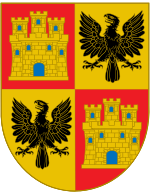Peter of Castile, Lord of Cameros
- View a machine-translated version of the Spanish article.
- Machine translation, like DeepL or Google Translate, is a useful starting point for translations, but translators must revise errors as necessary and confirm that the translation is accurate, rather than simply copy-pasting machine-translated text into the English Wikipedia.
- Consider adding a topic to this template: there are already 5,008 articles in the main category, and specifying
|topic=will aid in categorization. - Do not translate text that appears unreliable or low-quality. If possible, verify the text with references provided in the foreign-language article.
- You must provide copyright attribution in the edit summary accompanying your translation by providing an interlanguage link to the source of your translation. A model attribution edit summary is
Content in this edit is translated from the existing Spanish Wikipedia article at [[:es:Pedro de Castilla y Molina]]; see its history for attribution. - You may also add the template
{{Translated|es|Pedro de Castilla y Molina}}to the talk page. - For more guidance, see Wikipedia:Translation.
Peter of Castile | |
|---|---|
| Lord of Cameros | |
 Arms of Infante of Castile | |
| Born | 1290 Valladolid |
| Died | 25 June 1319 (aged 29) Pinos Puente |
| Noble family | Castilian House of Ivrea |
| Spouse(s) | María of Aragon |
| Issue | Blanche of Castile |
| Father | Sancho IV |
| Mother | María de Molina |
Peter of Castile, in Spanish Pedro de Castilla (1290 – 25 June 1319), was an infante of Castile, a younger son of King Sancho IV and his wife María de Molina. He held the lordships (señoríos) of Cameros, Almazán, Berlanga, Monteagudo and Cifuentes and was the majordomo of his brother, King Ferdinand IV of Castile. During the minority of his nephew Alfonso XI, he shared the regency of Castile with his mother and uncle, John el de Tarifa, between 1313 and his death.
Peter married María, a daughter of King James II of Aragon. Their only child, Blanche, was born after Peter's death. Although she was betrothed to King Peter I of Portugal, the marriage never took place.
In 1313, an agreement [es] reached at Palazuelos [es] divided the regency of the young Alfonso XI between Peter, John and María, with the men being described as tutores. This was confirmed by a cortes at Burgos in 1315. Throughout the disputes over the regency in the years 1312–15 that often devolved into open conflict, Peter supported his mother and was often at odds with his uncle.[1]
In 1316, Peter led a military expedition to the frontier of the Kingdom of Granada. According to Christian sources, he won a great victory in the field, but unsuccessfully besieged two castles. Muslims sources mention no victory. In 1317, he again invaded Granada, relieving the siege of Gibraltar and capturing the castle of Bélmez de la Moraleda. In 1319, having received papal approval for a crusade against Granada, Peter and John jointly led an expedition to besiege the fortress of Tíscar. They separated their armies and were ambushed by a Muslim relief force. Both Peter and John were killed in the ensuing rout, known as the Disaster of the Vega de Granada.[2]
Notes
- ^ Pepin 2016, pp. 117–23.
- ^ Agrait 1998, pp. 151–52.
References
- Agrait, Nicolás (1998). "The Reconquest During the Reign of Alfonso XI". In Donald J. Kagay; Therese M. Vann (eds.). On the Social Origins of Medieval Institutions: Essays in Honor of Joseph F. O'Callaghan. Leiden: Brill.
- Pepin, Paulette Lynn (2016). María de Molina, Queen and Regent: Life and Rule in Castile-León, 1259–1321. Lexington Books.










